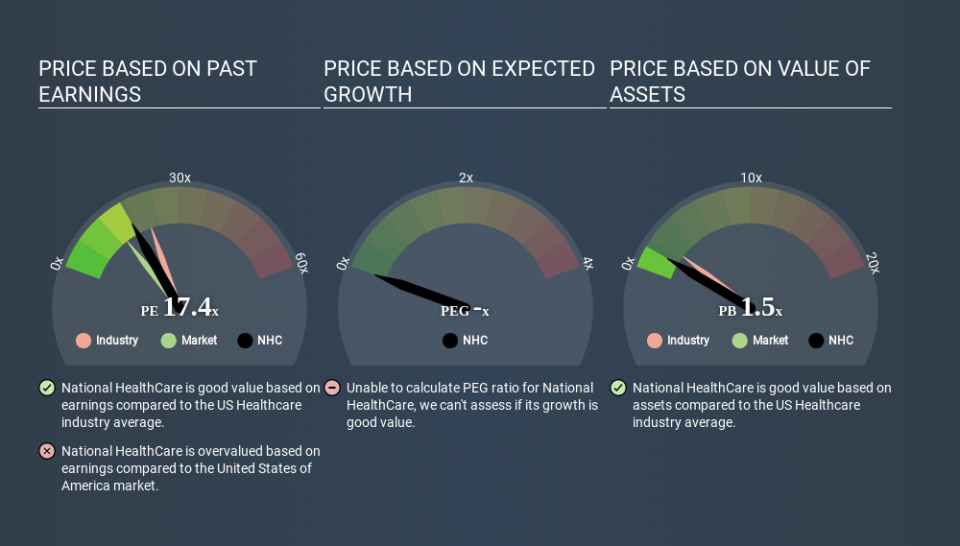How Does National HealthCare's (NYSEMKT:NHC) P/E Compare To Its Industry, After Its Big Share Price Gain?

Those holding National HealthCare (NYSEMKT:NHC) shares must be pleased that the share price has rebounded 37% in the last thirty days. But unfortunately, the stock is still down by 11% over a quarter. Unfortunately, the full year gain of 7.8% wasn't so sweet.
Assuming no other changes, a sharply higher share price makes a stock less attractive to potential buyers. While the market sentiment towards a stock is very changeable, in the long run, the share price will tend to move in the same direction as earnings per share. The implication here is that deep value investors might steer clear when expectations of a company are too high. Perhaps the simplest way to get a read on investors' expectations of a business is to look at its Price to Earnings Ratio (PE Ratio). Investors have optimistic expectations of companies with higher P/E ratios, compared to companies with lower P/E ratios.
See our latest analysis for National HealthCare
Does National HealthCare Have A Relatively High Or Low P/E For Its Industry?
We can tell from its P/E ratio of 17.43 that sentiment around National HealthCare isn't particularly high. We can see in the image below that the average P/E (21.7) for companies in the healthcare industry is higher than National HealthCare's P/E.
National HealthCare's P/E tells us that market participants think it will not fare as well as its peers in the same industry. Since the market seems unimpressed with National HealthCare, it's quite possible it could surprise on the upside. If you consider the stock interesting, further research is recommended. For example, I often monitor director buying and selling.
How Growth Rates Impact P/E Ratios
Earnings growth rates have a big influence on P/E ratios. If earnings are growing quickly, then the 'E' in the equation will increase faster than it would otherwise. And in that case, the P/E ratio itself will drop rather quickly. Then, a lower P/E should attract more buyers, pushing the share price up.
It's great to see that National HealthCare grew EPS by 15% in the last year. And its annual EPS growth rate over 5 years is 6.7%. So one might expect an above average P/E ratio.
Don't Forget: The P/E Does Not Account For Debt or Bank Deposits
One drawback of using a P/E ratio is that it considers market capitalization, but not the balance sheet. So it won't reflect the advantage of cash, or disadvantage of debt. In theory, a company can lower its future P/E ratio by using cash or debt to invest in growth.
Such expenditure might be good or bad, in the long term, but the point here is that the balance sheet is not reflected by this ratio.
National HealthCare's Balance Sheet
With net cash of US$193m, National HealthCare has a very strong balance sheet, which may be important for its business. Having said that, at 16% of its market capitalization the cash hoard would contribute towards a higher P/E ratio.
The Verdict On National HealthCare's P/E Ratio
National HealthCare trades on a P/E ratio of 17.4, which is above its market average of 13.7. Its net cash position supports a higher P/E ratio, as does its solid recent earnings growth. So it is not surprising the market is probably extrapolating recent growth well into the future, reflected in the relatively high P/E ratio. What we know for sure is that investors have become more excited about National HealthCare recently, since they have pushed its P/E ratio from 12.8 to 17.4 over the last month. If you like to buy stocks that have recently impressed the market, then this one might be a candidate; but if you prefer to invest when there is 'blood in the streets', then you may feel the opportunity has passed.
Investors should be looking to buy stocks that the market is wrong about. As value investor Benjamin Graham famously said, 'In the short run, the market is a voting machine but in the long run, it is a weighing machine. We don't have analyst forecasts, but shareholders might want to examine this detailed historical graph of earnings, revenue and cash flow.
But note: National HealthCare may not be the best stock to buy. So take a peek at this free list of interesting companies with strong recent earnings growth (and a P/E ratio below 20).
If you spot an error that warrants correction, please contact the editor at editorial-team@simplywallst.com. This article by Simply Wall St is general in nature. It does not constitute a recommendation to buy or sell any stock, and does not take account of your objectives, or your financial situation. Simply Wall St has no position in the stocks mentioned.
We aim to bring you long-term focused research analysis driven by fundamental data. Note that our analysis may not factor in the latest price-sensitive company announcements or qualitative material. Thank you for reading.

